GRAND CANYON (Day 7 - part 3)
Tusayan was the location of a ruin and a small museum.

The museum

The museum contained some of the oldest artifacts from the Grand Canyon as well as displays of the current cultures that still reside here today. It was kept dark inside to protect the colors, fabrics and baskets.

The Grand Canyon sat on the western border of their realm. Anasazi is the old Navajo word meaning 'ancient enemies.' The Hopi, one of their over 20 different tribes of descendants, call them the Hisatsinom, while today the rest of us generally use the term Ancestral Puebloans.


Bone tools

Two to four thousand years ago, during the Archaic culture, people made animal figurines from split twigs. Most were found hidden under rocks up in caves that were extremely difficult to reach and that had no other indication of human use.

The Navajo, Hopi, Havasupai and Hualapai are some of the major modern day tribes in the area.
We then went outside to see the ruins. Ancestral Puebloans built this site around 1185. It was excavated in 1930 and named Tusayan after the Spanish name for the area (although we no longer know what the word means). It was a small village of only about 30 people who lived here for 25 to 30 years. Pottery shards and tree ring dating of the support beams helped determine the age of the site.
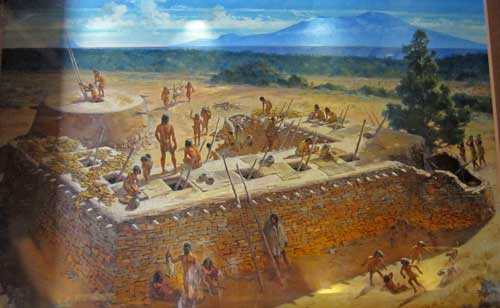
This is an artist's depiction of what Tusayan Publo may have appeared in autumn, 800 years ago... drying corn and grinding meal, kids playing with domesticated dogs, the successful hunt of deer and rabbits, swaddled babies, ceramic pots... (Click for a larger view)

This ruin is one of 4,300 archeological sites recorded within Grand Canyon National Park. The plaza faces south to take advantage of the warmth of the low winter sun. It also provided a view of the distant sacred mountains.

Limestone blocks were held together with mud.

It is guessed these rooms were used for storage since there were no signs of habitation within them. Piles of corn, beans or pine nuts in clay jars, seeds for next year's harvest, grinding stones, etc. Without stored food, there would be no surviving the hard winters.

This small kiva burned at some point in time. Rather than rebuilding it in the same spot, another one was built nearby to replace it.

The large kiva. A kiva was a ceremonial room. Its basic structure was developed from older pithouses, which were more above ground. 'Kiva' is the Hopi word for 'room underneath'. It stayed warm in winter and cool in summer.

The typical kiva layout
The center opening would have been above fire pit. Air vents would have ensured that the fire didn't go out and the room didn't get too smoky. The only real question is the sipapu, which means 'place of emergence'. Every kiva has one but it seems to offer no functional purpose. According to a story from the Hopi, there are four worlds. We are currently in the fourth. They are kind of like parallel universes... connected by this sipapu. This one is, of course, only a representation of the real one.

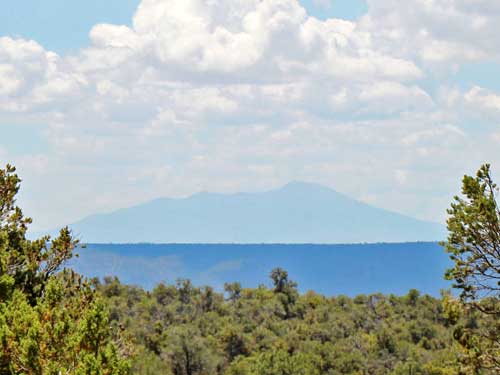
Some 48 miles south of here (next to Flagstaff) looms Humphreys Peak (12,633 feet), the highest point in Arizona. The San Francisco Peaks were once active volcanos. They only formed in the past six million years and have been active as recently as 1,000 years ago. In Hopi tradition, the spirits (or kachinas) live in the peaks during the winter.
The forest was the native people's supermarket and a short trail led past some of their most popular items.



Utah Juniper wood was used for fuel and building materials; berries were eaten, bark was used as bedding.

Pinyon Pine had wood for building and fires; delicious nuts; sap for waterproofing baskets.

Back then, these were probably also on the menu!
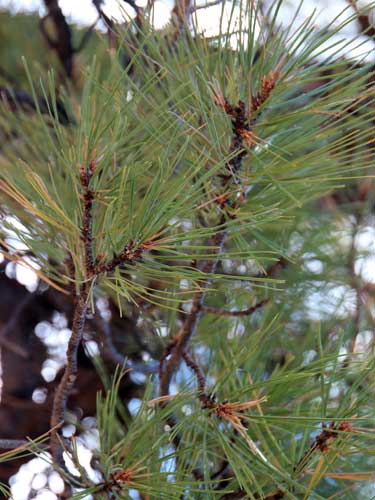
Ponderosa Pines were used as main beams for pueblos; needles were woven into baskets; nuts were eaten.
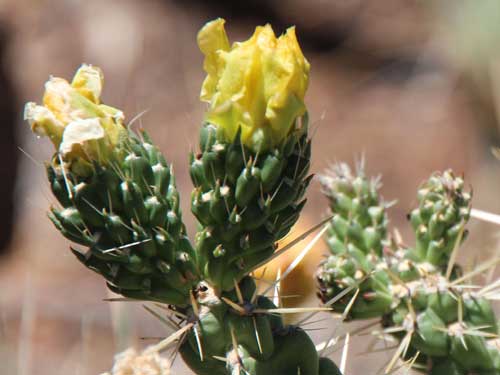
Prickly pears are apparently delicious on the inside… if you're careful!

Mormon Tea had many medicinal purposes.
We then continued on to Grandview overlook. Traffic was starting to get very thick and parking became more and more difficult to find, even in the handicapped areas.

Mountain lions (also known as pumas and cougars) do not see humans as prey and so are therfore not a threat. For the mountain lions, however, being hit by cars is a common cause of death.

Waiting to enter the parking lot
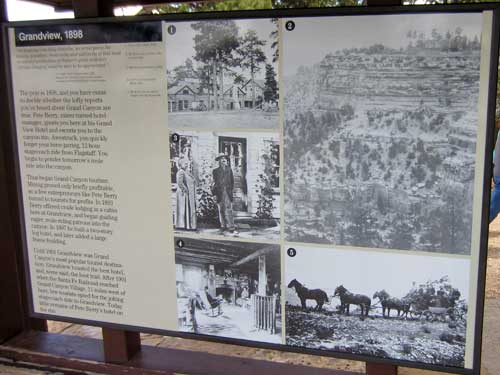
In 1890, prospector Pete Berry staked the Last Chance copper claim some 3,000 feet below us on Horseshoe Mesa. The mine survived for a while, but eventually the high cost of hauling it up to the rim and then shipping it to Texas proved to be its doom. But the gateway had been opened for tourism, which took root in 1893, first with crude lodgings then in 1897 with the two-story log Grandview Hotel run by miner-turned-hotel-manager Berry. It was a 12-hour jarring stagecoach ride to get here from Flagstaff, but the reward was a mule ride down into the canyon (and the grand view, of course). Grandview's success ended when the railroad built a line to Grand Canyon Village (11 miles away) in 1901.

Mules and burros carried 200-pound loads of copper ore up the trail.

The original trail was one of the finest constructed trails in the canyon. It can still be hiked today although it is in far worse shape now due to lack of maintanance.

It is actually considered one of the more dangerous trails, resulting in serious injury and death every year. The first section drops 2,600 vertical feet in a less than 3 miles. Steep, steep, steep!

Summer temperatures can reach 115 degrees F (in the shade!) and it becomes icy and below freezing in the winter. In the fall, monsoons can build large, violent lightning storms. At least 150 people per year have to be rescued by helicopter in the canyon.

A view east of Horseshoe Mesa...

... and the old location of the mine.

Looking west
There were a few unmarked pullout and stops not on the map that also offered amazing views.

A stop alongside the road



Duck on a Rock viewpoint

The duck got a visit from President Dwight D. Eisenhower in the 1950's.
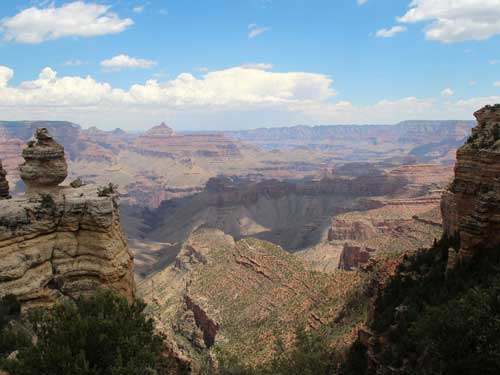


New friends
return • continue

